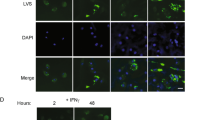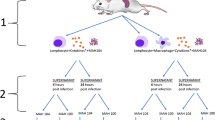Abstract
Francisella tularensis is capable to modulate immunobiological activities of the host cells. We focused on the expression of ICAM-1 (CD54) on J774.2 mouse macrophage cell line infected by F. tularensis live vaccine strain (LVS) in vitro as a putative marker of subsequent elimination of infection. J774.2 cell line cells were infected by F. tularensis LVS strain (multiplicity of infection, 1:100). Cell cultures were stimulated either 3 h before infection or 3 h after infection by either lipopolysaccharide (LPS) or interferon γ (IFN-γ). The expression of ICAM-1 was determined by flow cytometry 6 h after infection. The intensity of ICAM-1 expression after 6 h of J774.2 macrophage cells infection by F. tularensis is very sensitive indicator of the effective macrophages stimulation resulting in the elimination of F. tularensis infection. The mean fluorescence intensity MFI = 49.8 is set-up by our experiments as a reliable threshold of the effective elimination of F. tularensis experimental infection with 83.3% sensitivity and 96.7% specificity, respectively. Simultaneous stimulation of J774.2 macrophage cells by LPS and IFN-γ was essential to elicit the elimination of F. tularensis infection. The ICAM-1 expression determined by flow cytometry can be considered to be highly sensitive and specific approach to predict elimination of F. tularensis infection by J774.2 macrophages.


Similar content being viewed by others
Abbreviations
- ATCC:
-
American Type Culture Collection
- CDC:
-
Centre for Disease Control
- CFU:
-
Colony forming units
- ETCC:
-
European Type Culture Collection
- FITC:
-
Fluorescein isothiocyanate
- F. tularensis :
-
Francisella tularensis
- HSD:
-
Honestly significant difference (post hoc test)
- ICAM:
-
Intercellular adhesion molecule
- IL:
-
Interleukin
- IFN-γ:
-
Interferon γ
- LPS:
-
Lipopolysaccharide
- LVS:
-
Live vaccine strain
- MAPK:
-
Mitogen-activated protein kinase
- MEM:
-
Modified Eagle’s medium
- MFI:
-
mean fluorescence index
- MOI:
-
Multiplicity of infection
- NFκB:
-
Nuclear factor κB
- PBS:
-
Phosphate-buffered saline
- ROC:
-
Receiver operating characteristics curve
- AUROC:
-
Area under ROC curve)
- TLR:
-
Toll-like receptor
- TNF-α:
-
Tumor necrosis factor α
References
Abd H, Johansson T, Golovliov I, Sandstrom G, Forsman M (2003) Survival and growth of Francisella tularensis in Acanthamoeba castellanii. Appl Environ Microbiol 69:600–606
Ashtekar AR, Zhang P, Katz J, Deivanayagam CC, Rallabhandi P, Vogel SN, Michalek SM (2008) TLR4-mediated activation of dendritic cells by the heat shock protein DnaK from Francisella tularensis. J Leukoc Biol 84:1434–1446
De PR, Taylor BC, Elkins KL (2008) Diverse myeloid and lymphoid cell subpopulations produce gamma interferon during early innate immune responses to Francisella tularensis live vaccine strain. Infect Immun 76:4311–4321
Ericsson M, Kroca M, Johansson T, Sjostedt A, Tarnvik A (2001) Long-lasting recall response of CD4+ and CD8+ α/β T cells, but not γ/δ T cells, to heat shock proteins of Francisella tularensis. Scand J Infect Dis 33:145–152
Golovliov I, Baranov V, Krocova Z, Kovarova H, Sjostedt A (2003) An attenuated strain of the facultative intracellular bacterium Francisella tularensis can escape the phagosome of monocytic cells. Infect Immun 71:5940–5950
Hall JD, Woolard MD, Gunn BM, Craven RR, Taft-Benz S, Frelinger JA, Kawula TH (2008) Infected-host-cell repertoire and cellular response in the lung following inhalation of Francisella tularensis Schu S4, LVS, or U112. Infect Immun 76:5843–5852
Hrstka R, Stulík J, Vojtěšek B (2005) The role of MAPK signaling pathway during Francisella tularensis LVS infection-induced apoptosis in murine macrophages. Microbes Infect 7:619–625
Hrstka R, Kročová Z, Černý J, Vojtěšek B, Macela A, Stulík J (2007) Francisella tularensis strain LVS resides in MHC II-positive autophagic vacuoles in macrophages. Folia Microbiol 52:631–636
Janovská S, Pávková I, Reichelová M, Hubálek M, Stulík J, Macela A (2007) Proteomic analysis of antibody response in a case of laboratory-acquired infection with Francisella tularensis subsp. tularensis. Folia Microbiol 52:194–198
Lai XH, Sjostedt A (2003) Delineation of the molecular mechanisms of Francisella tularensis-induced apoptosis in murine macrophages. Infect Immun 71:4642–4646
Lai XH, Golovliov I, Sjostedt A (2004) Expression of IglC is necessary for intracellular growth and induction of apoptosis in murine macrophages by Francisella tularensis. Microb Pathogenesis 37:225–230
Perroud TD, Kaiser JN, Sy JC, Lane TW, Branda CS, Singh AK, Patel KD (2008) Microfluidic-based cell sorting of Francisella tularensis infected macrophages using optical forces. Anal Chem 80:6365–6372
Pohanka M, Skládal P (2007) Piezoelectric immunosensor for the direct and rapid detection of Francisella tularensis. Folia Microbiol 52:325–330
Pohanka M, Skládal P (2009) Bacillus anthracis, Francisella tularensis and Yersinia pestis. The most important bacterial warfare agents—review. Folia Microbiol 54:263–272
Santic M, Pavokovic G, Jones S, Asare R, Kwaik YA (2010) Regulation of apoptosis and anti-apoptosis signalling by Francisella tularensis. Microbes Infect 12:126–134
Telepnev M, Golovliov I, Grundstrom T, Tarnvik A, Sjostedt A (2003) Francisella tularensis inhibits Toll-like receptor-mediated activation of intracellular signaling and secretion of TNF-α and IL-1 from murine macrophages. Cell Microbiol 5:41–51
Telepnev M, Golovliov I, Sjostedt A (2005) Francisella tularensis LVS initially activates but subsequently down-regulates intracellular signaling and cytokine secretion in mouse monocytic and human peripheral blood mononuclear cells. Microb Pathog 38:239–247
Acknowledgment
The study was supported by grant no. LN00A033 and, in part, also by project no. MSM0021620812 of the Ministry of Education, Youth and Sport, Czech Republic.
Author information
Authors and Affiliations
Corresponding author
Rights and permissions
About this article
Cite this article
Novosad, J., Holicka, M., Novosadova, M. et al. Rapid onset of ICAM-1 expression is a marker of effective macrophages activation during infection of Francisella tularensis LVS in vitro. Folia Microbiol 56, 149–154 (2011). https://doi.org/10.1007/s12223-011-0028-y
Received:
Accepted:
Published:
Issue Date:
DOI: https://doi.org/10.1007/s12223-011-0028-y




